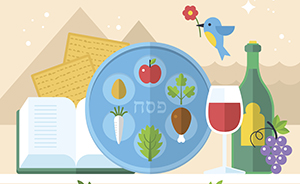 It all begins with a question. “Why is this night different from all other nights?” Inherent in the question is the idea that when a child comes to dinner that night, there is something that is not part of the usual routine. Passover is the ultimate in home family holiday, so the preparation and celebration of the holiday make a huge imprint on kids The seder table helps us keep track of the everyone – the years of smaller gatherings as kids go off to college are replaced with additional high chairs and tables. Which boyfriends and girlfriends have rated an invitation? Who is now, sadly, no longer with us. Who conducts your seders, who is included, who asks the questions, what is on the menu? These traditions do not just spring up but are started when you have young children.
It all begins with a question. “Why is this night different from all other nights?” Inherent in the question is the idea that when a child comes to dinner that night, there is something that is not part of the usual routine. Passover is the ultimate in home family holiday, so the preparation and celebration of the holiday make a huge imprint on kids The seder table helps us keep track of the everyone – the years of smaller gatherings as kids go off to college are replaced with additional high chairs and tables. Which boyfriends and girlfriends have rated an invitation? Who is now, sadly, no longer with us. Who conducts your seders, who is included, who asks the questions, what is on the menu? These traditions do not just spring up but are started when you have young children.
With marriage comes not only the uniting of two people, but also the merging of family customs. Where you will be for Passover is the first big question. Other issues are smaller, but can still bring out emotional attachments. You are from a family that hid the afkoman each year and your spouse’s family stole it from each other throughout the meal. Whose cherished matza ball recipe gets used?
Here are some useful tips to get through the holiday:
Find a Haggadah that fits your needs. When my kids were little we found a Haggadah that put all of the food blessings up front so we could nosh on chorosset and greens throughout the telling of the story. We opted out of a specific children’s haggadah as we wanted one that would be familiar year to year, but there are many options including ones to keep kids busy.
Seders are important rituals that should not solely revolve around children . Hire a sitter to stay with some activities in another room so kids can get up and down as needed without participating adults having to constantly follow them. Figure out ahead of time the age at which you expect children to sit through the seder.
Think about kids and food. Decide ahead of the holiday what your expectations are for feeding the kids. Do you strictly adhere to all Passover guidelines or just not have bread in their lunch boxes for a week. I know one very observant family who said that for one hour on Easter, when there was a neighborhood egg hunt, their kids could eat anything they found, so that Passover wasn’t resented. Make sure that kids know the rules ahead of time.
Be creative – invent customs that work for your family with the idea that not all are keepers. One year we removed all the furniture, covered the floor with kid decorated plastic and brought pillows to truly recline as we had our seder. By the third time someone stepped in the salt water, the idea of continuing this custom was done but 30 years later it is still remembered. Supposedly my great grandmother always had someone waiting outside so when they recited “let all who are hungry come and eat”, someone entered to join in the meal.
Passover conveys the main beliefs of our religion. We need to remember those less fortunate, know that justice applies to all, be cognizant of the food we eat, and that there are traditions that unite us all.
Sing – the songs are a great part of the seder. Integrate the preschool songs with the more traditional ones. Getting through each verse of Had Gadya in one breath unites participants of all ages.
The seder is a great multi-generational rite that sets forth the basic values of our religion. Start creating traditions now that will bring your family and friends back year after year.
Judy Callahan is director of B’nai Simcha Jewish Community Preschool and a member of PJTC.






